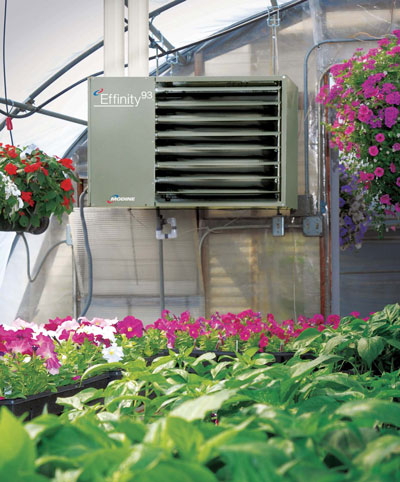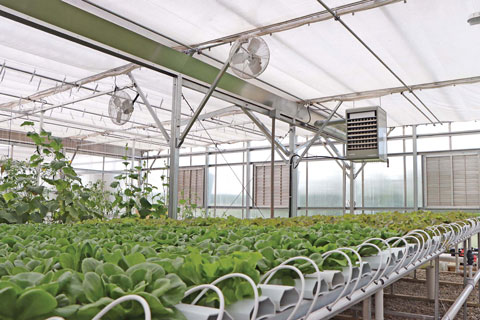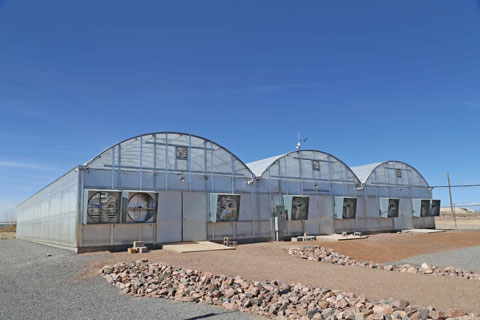10/1/2022
Heating in Your Winter Greenhouse
Patrick Mahoney

One of the appeals of growing in a greenhouse is being able to continue production year-round. Still, in order to accomplish that feat, operations need an effective strategy in place to maintain success when the cold season hits. For northern growers in particular, it’s important they find ways to effectively heat their greenhouse while still remaining energy efficient.
Colder temperatures generally correlate to higher utility costs; that’s a reality northern growers have to be increasingly conscious of when using climate controls. If these operations aren’t prepared with the right equipment or structural design, they can waste a significant amount of money trying to heat their grow space, as well as hinder crops from reaching their full potential.
Pictured: To truly optimize heating, growers need to ensure they’re getting the most efficiency out of their heating system.
Fortunately, there are a number of ways for growers to improve their greenhouse and limit expenses during winter. To get the most out of their structure, operations will want to look at the key factors that impact heating efficiency, starting with the greenhouse’s ability to retain heat and the effectiveness of its heating system.
Cladding and heat retention
Installing cladding that possesses a high R-value is crucial to staying energy efficient in the cold season. Without an effective cladding, growers will lose heat from their structure at a faster pace, which means their heating system is going to have to run more frequently to try and achieve an optimal temperature range. Over the duration of an entire cold season, this can waste substantial amounts of energy. For high-level insulation, northern growers may even want to go a step beyond traditional cladding with their structure.
“It makes a lot of sense to build a knee wall in addition to your foundation and it might even make sense to clad the sides of the greenhouse with insulated metal panels,” said Matthew Hively, a greenhouse designer for GrowSpan Green-house Structures. “When you insulate metal sidewall paneling, you can have an incredibly well-insulated structure up until you get to the roof.”
When it comes to the roof, polycarbonate is one of the best options available for cold-climate growers. A quality cladding, like 8 mm twin-wall polycarbonate, is going to provide growers with an extremely high R-value that gives their greenhouse excellent heat retention. Simultaneously, crops will still receive the light transmission and UV protection they need to thrive.
Once the structure itself is taken care of, growers can start to think about additional insulation to bolster their greenhouse’s energy efficiency.
According to Matthew, this is when growers should “absolutely consider heat-retention curtains.” By implementing heat-retention curtains and closing them during the night, growers can keep existing heat inside of their greenhouse, while barely having to run their heaters. Most of the heat will stay sealed inside of those insulated barriers, protecting crops when outdoor temperatures are at their lowest.
 Pictured: The right cladding can provide effective insulation and valuable light transmission, lowering costs and improving yields.
Pictured: The right cladding can provide effective insulation and valuable light transmission, lowering costs and improving yields.
Another factor for growers to consider is their structure’s ventilation. Ideally, northern growers aren’t going to want to run their exhaust fans if they don’t have to because it will allow cold air to enter the greenhouse and expel warm air that ultimately needs to be replaced.
If necessary, growers can use exhaust fans intermittently to conserve energy and avoid any drastic temperature changes. “If you do use ventilation fans, you’re probably going to want to use them in short amounts and mix that cold air in with the hot air,” said Matthew. “That way, you don’t shock the plants and evacuate all this hot air and bring cold air in suddenly.”
Optimizing your heating system
To truly optimize heating, growers need to ensure they’re getting the most efficiency out of their heating system. This means determining which type of fuel source is going to be the best option for them based on their location, as well as installing their heating system correctly to achieve consistent temperatures.
Electricity is by far the least-efficient fuel source, which leaves growers to decide between propane or natural gas for their heaters. To make the best decision, Matthew believes growers should do an economic study and see which of the two fuel sources is going to be the most cost-effective for them.
“It’s a good idea for growers to look at what the rates are for propane and natural gas,” he explained. “Growers may find they are spending a lot of money to heat with propane, when it makes more sense for them to buy a contract for natural gas.”
After determining an ideal fuel source, growers can then begin to focus on optimizing their actual heating system. Initially, growers should ensure their heaters are installed correctly so they can produce uniform heating throughout their greenhouse.
“A big mistake I see growers make is not splitting up their heaters and placing one at each opposite end of the greenhouse,” said Matthew. “You can lose heat from your greenhouse this way because it’s travelling across the greenhouse and trying to make it to the other side.”
For growers in smaller greenhouses, two heaters may not be necessary. However, for commercial growers with bays spanning over 40 ft. in length, installing multiple heaters and placing them in opposite corners of the structure can really help optimize energy
efficiency.
A horizontal airflow fan system (HAF) can also be useful for encouraging more efficient heating. HAF fans can effectively mix the air around and help distribute heat evenly throughout a greenhouse, which is highly beneficial for growers who utilize temperature sensors.
“An even distribution of heat will tell your sensor that there’s enough heat in the greenhouse, eliminating any kind of wasted propane or natural gas,” said Matthew.
 Pictured: Utilizing cladding with a high R-value is crucial to staying energy-efficient in the cold season.
Pictured: Utilizing cladding with a high R-value is crucial to staying energy-efficient in the cold season.
In addition to temperature sensors, employing automation through a smart controller is a valuable tool for northern growers utilizing climate controls. These controllers assist with data collection, allowing growers to analyze the behavior of their equipment, so they can coordinate and synchronize their systems for maximum efficiency.
“What really adds value to automation is when growers can look at their historical data, including things like how their temperature was maintained, what the humidity levels were and then also correlate that with when certain pieces of equipment came on,” said Matthew. “With this analysis tool, they can make sure they aren’t wasting the efforts of one piece of equipment when another piece of equipment is not engaged.”
Although winter can be daunting for northern growers, optimizing heating and staying energy efficient doesn’t have to be a complicated process. With effective insulation, uniform distribution of heat and tools to retain that heat, greenhouse operations can successfully implement climate controls and stay profitable during the cold season. GT
Patrick Mahoney is a copywriter and content specialist for GrowSpan Greenhouse Structures. For more information, visit GrowSpan.com.